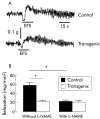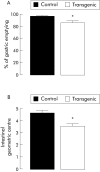Changes in enteric neurone phenotype and intestinal functions in a transgenic mouse model of enteric glia disruption
- PMID: 16236773
- PMCID: PMC1856141
- DOI: 10.1136/gut.2005.067595
Changes in enteric neurone phenotype and intestinal functions in a transgenic mouse model of enteric glia disruption
Abstract
Aims: The influence of enteric glia on the regulation of intestinal functions is unknown. Our aim was to determine the phenotype of enteric neurones in a model of glia alterations and the putative changes in intestinal motility and permeability.
Methods: Transgenic mice expressing haemagglutinin (HA) in glia were used. Glia disruption was induced by injection of activated HA specific CD8+ T cells. Control mice consisted of non-transgenic littermates injected with activated HA specific CD8+ T cells. Immunohistochemical staining for choline acetyltransferase (ChAT), substance P (SP), vasoactive intestinal peptide (VIP), and nitric oxide synthase (NOS) was performed on jejunal submucosal plexus (SMP) and myenteric plexus (MP). Neurally induced jejunal muscle activity was characterised in vitro. Gastrointestinal transit and paracellular permeability were measured using fluorescein isothiocyanate-dextran markers.
Results: CD3 positive T cells infiltrates were observed in the MP of transgenic mice. In the SMP, the proportions of VIP and SP positive neurones decreased in transgenic mice compared with control mice. ChAT remained unchanged. In the MP, the proportions of ChAT and NOS positive neurones increased and decreased, respectively, in transgenic mice. In contrast, VIP and SP remained unchanged. Neurally mediated jejunal relaxation was lower in transgenic mice than in controls. This relaxation was reduced by NG-nitro-L-arginine methyl ester in control mice but not in transgenic mice. Gastrointestinal transit was delayed and intestinal permeability increased in transgenic mice compared with control mice.
Conclusion: Glia disruption induces changes in the neurochemical coding of enteric neurones, which may partly be responsible for dysfunctions in intestinal motility and permeability.
Conflict of interest statement
Conflict of interest: None declared.
Comment in
-
Glial regulation of neuronal plasticity in the gut: implications for clinicians.Gut. 2006 May;55(5):600-2. doi: 10.1136/gut.2005.084426. Gut. 2006. PMID: 16609131 Free PMC article.
References
-
- Gabella G. Ultrastructure of the nerve plexuses of the mammalian intestine: the enteric glial cells. Neuroscience 19816425–436. - PubMed
-
- Jessen K R, Mirsky R. Glial cells in the enteric nervous system contain glial fibrillary acidic protein. Nature 1980286736–737. - PubMed
-
- Cabarrocas J, Savidge T C, Liblau R S. Role of enteric glial cells in inflammatory bowel disease. Glia 20034181–93. - PubMed
Publication types
MeSH terms
Substances
LinkOut - more resources
Full Text Sources
Molecular Biology Databases
Research Materials








